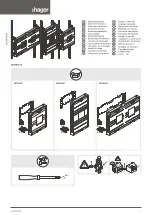
Manual | MNS-SG Operation and Maintenance 31
Place the Link to join with the next section
The Switchgear must be grounded to the ground system
designed by either a star or delta connection and the
resistance must be a minimum of 0,001
Ω
to ensure a
good residual energy drain.
Refer to the Torque Table for all tightening torques for
horizontal buss bolted connections.
Ground the Switchgear ground bus using equipment-
grounding conductors sized according to NEC 250-94, or
by bonding the ground bus to the raceway enclosing the
main supply conductors according to NEC 250-92(B).
NOTE:
Do not use abrasive cleaners on the bus joints.
Failure to follow this instruction can result in high
resistance connections.
Additional connections to the central ground system and
the Switchgear ground bus can be made at any point on
the perforated ground bus. Ground cables should not be
run in conduit and should take the most direct path to the
site ground.
4.7.
Attach switchgear to floor
After completing the internal connections, attach the
switchgear to its location. Switchgear may be:
-
Attached to a base frame that has been secured to the
floor (preferred method).
-
Bolted directly to a concrete floor by setting vertical
mounting bolts in the floor.
-
Bolted to floor channels.
-
Bolted to a false floor. A minimum floor height of 20.0 in
(500 mm) is recommended to accommodate the bending
radius of the cables and provide adequate accessibility.
The false floor must have a carrying capacity of 20 kN/m2
(2.9 PSI) compression load from top to bottom.
Attach the sections using four bolts through the holes in the
section base to the floor or base frame. Use M8 (5/16 in) or
larger hardware. Torque to 14 ft/lbs (20 Nm).
Floor mounting anchor plan
The SG with seismic structure or with base channels can be
welded to the floor. However, it is recommended that the
customer follow appropriate welding techniques and treat
the welded area with a corrosion-resistant coating.
4.8.
Attach overhead lifting device
A traveling, overhead lifting device is available to assist with
handling breakers. The front section of the switchgear
provides support for the lifting device. The device travels
the full width of the switchgear.
The breaker lifts from the floor or from a completely
withdrawn circuit breaker cradle with a lifting yoke. A worm-
gear-driven mechanism and wire rope, operated by a
removable hand crank, provide lifting power.
Although the driving mechanism allows for easy hand
operation, the weight of the circuit breaker cannot
accidentally move the mechanism. See the corresponding
ABB drawing for detailed operating instructions.
The reinforcement only
applies for the seismic
and ARC configurations
















































